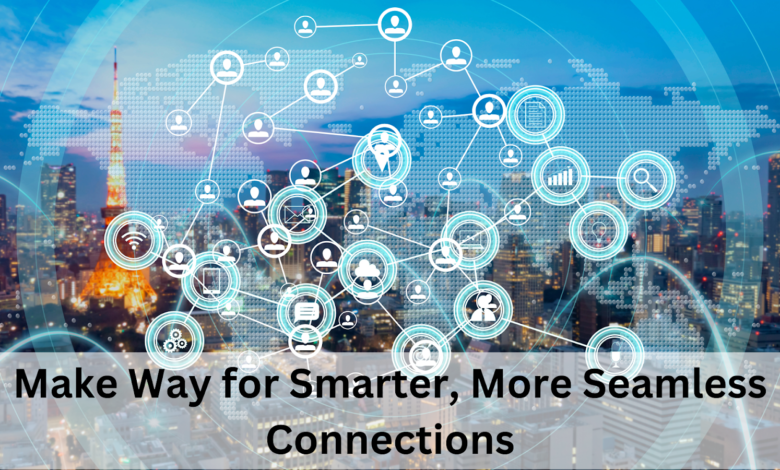Make Way for Smarter, More Seamless Connections

How will the future of connectivity change the world around us? As we enter an era of rapid technological growth, the future of connectivity promises smarter, more seamless connections that will change the way we work, live and interact with the world. Industries like healthcare, transportation, manufacturing, and even our cities will benefit from enhanced communication and automation. Smart homes will also see a transformative shift, offering personalized, energy-efficient living experiences through advanced connectivity. In this blog, we’ll explore the key trends shaping the future of connectivity and how they will impact industries and consumers alike.
The Evolution of Connectivity: From 5G to 6G
The Shift from 5G to 6G
The jump from 5G to 6G is one of the most significant developments in the world of wireless technology. While 5G has already delivered faster speeds and lower latency, 6G is set to take these advancements even further.
6G technology is projected to offer speeds that are up to 100 times faster than 5G, allowing data to travel in the blink of an eye. This leap in speed will have profound effects on industries that rely on high-speed communication, such as healthcare, education, and manufacturing.
How 6G Will Enhance Connectivity
6G’s ultra-low latency will revolutionize AI-powered network management and high-speed data transmission, enabling real-time data processing with negligible delay. This is essential for industries such as healthcare, where doctors need real-time data to make life-saving decisions, and transportation, where autonomous vehicles depend on rapid communication for safety.
In France, where technological advancements are rapidly reshaping various sectors, this type of connectivity is becoming a foundational. As part of this progress, esim france technology ensures seamless connectivity across devices, enabling uninterrupted communication. For instance, in the healthcare industry, doctors will be able to perform surgeries remotely, with AI-driven connectivity ensuring that every movement is translated instantly to robotic instruments.
The Role of Artificial Intelligence in Seamless Connectivity
How AI Optimizes Connectivity
AI is not only a key player in network optimization techniques, but it is also revolutionizing how networks are managed and maintained. Through AI-driven connectivity, networks can become self-healing and adaptive, constantly adjusting their performance based on real-time data. AI helps networks automatically identify and solve issues, often before users even notice them.
AI-powered network management ensures that data flows smoothly across networks, optimizing routes and minimizing downtime. The market for AI technologies is expected to grow by over 1.8 trillion U.S. dollars by 2030. By analyzing network traffic and patterns, AI can predict when maintenance is needed and optimize bandwidth allocation, enhancing overall performance.
AI-Powered Connectivity in Action
A great example of this is IoT integration in connectivity. In smart homes, AI can learn from users’ behaviors to adjust temperature, lighting, and even appliances, ensuring maximum comfort and energy efficiency.
In autonomous vehicles, AI ensures smooth communication between vehicles, traffic signals, and infrastructure to navigate safely in real time. These AI-powered systems not only improve efficiency but also create a more personalized and seamless experience for consumers.
The Internet of Things (IoT) and Its Expanding Ecosystem
IoT Expansion
The IoT is growing at an unprecedented rate, with more devices being connected to the internet every day. From smart thermostats to connected cars, the integration of IoT in connectivity is creating an interconnected ecosystem that spans industries, homes, and cities. By 2025, it’s expected that there will be more than 41 billion IoT devices in use.
This growth is driving the next phase of smarter systems. Here’s how:
- Energy Management: IoT devices are helping homes and businesses optimize energy usage, reducing waste and lowering costs.
- Transportation: Smart roads, connected vehicles, and traffic management systems will ensure smoother commutes and reduce congestion.
- Public Safety: IoT can enhance public safety by enabling smart surveillance, emergency response systems, and disaster management networks.
The Future of Smart Cities and Infrastructure
Smart City Connectivity Advancements
As cities around the world become smarter, smart city connectivity is evolving at an unprecedented rate. By integrating AI-driven connectivity, cities can optimize resources, improve public services, and reduce waste.
For example, smart grids allow cities to more effectively manage energy usage, while AI-powered traffic management systems can adjust signal timings based on real-time traffic conditions, ensuring smoother commutes and reducing emissions.
Overcoming Infrastructure Challenges
Appropriately, infrastructure development must bring support to such advances, where countless cities have built legacy systems that were hardly made to withstand the robustness and complication inherent in modern low-latency networking and high-speed data transmission.
The transition from some antiquated systems to communications systems with a future orientation is indeed mind-boggling and investment-heavy, while careful planning is necessary. But the dividends are just undoubted.
From better traffic management to more efficient public services and improved air quality, smart city connectivity powered by advanced technologies like AI and IoT is already improving urban life in cities.
The Impact on Consumer Experiences
Enhanced User Interactions
Consumers will experience an increase in uninterrupted seamlessness in their interactions as connections become better. Personalized shopping experiences, entertainment that flows, and intelligent customer service should shape up using seamless connectivity solutions to make the digital world feel more intuitive.
For example:
- Personalized Content: AI algorithms can curate content based on user preferences, ensuring that consumers always get relevant recommendations.
- Smarter Entertainment: Streaming services will adapt to bandwidth availability in real-time, ensuring smooth playback on any device.
Privacy and Security Considerations
The emergence of increased connectivity goes hand in hand with the shadow of privacy and security risks in data. With so many devices collecting a lot of personal data, there is a high need for safe networks. AI-powered network management makes this possible by detecting potential breaches and addressing the vulnerabilities before they escalate.
Conclusion
Connective Pathways that will lead into the future are already here, thanks to AI-driven Networks, integrated IoT, and forward-thinking technologies such as 6G. These technologies will recreate industries, maximize their effectiveness, and redefine everyday life as well. With the emerging future of an interconnected family, the possibilities are endless-more intelligent cities, more efficient services, and a seamless digital experience for everyone. Bright is the space and connected in every place.
FAQs
How will 6G technology differ from 5G in terms of real-world applications and high-speed data transmission?
6G is going to be much higher in speed levels to nearly 100 times increased speed when compared to 5G while having ultra-low latency. This makes it possible for the processing of data and the adoption of network management by Artificial Intelligence to optimize performance in various industries.
What are the primary security concerns associated with the proliferation of IoT integration in connectivity?
As more IoT devices come online, security issues can increasingly include unauthorized access, data breaches, and the lack of interoperability. AI-enabled connectivity and further robust encryption can mitigate these issues through continuous monitoring of network activities and secure data through transmission.
In what ways can AI-driven connectivity improve the efficiency of smart city connectivity?
These smart cities understand how to reduce their energy consumption and divert traffic, while at the same time providing better public safety, through evaluating real-time data from thousands of interconnected devices. This technology is enhanced through waste reduction, improved services, and the life quality of the residents.




